Everything you need to know about the Kakhovka HPP disaster
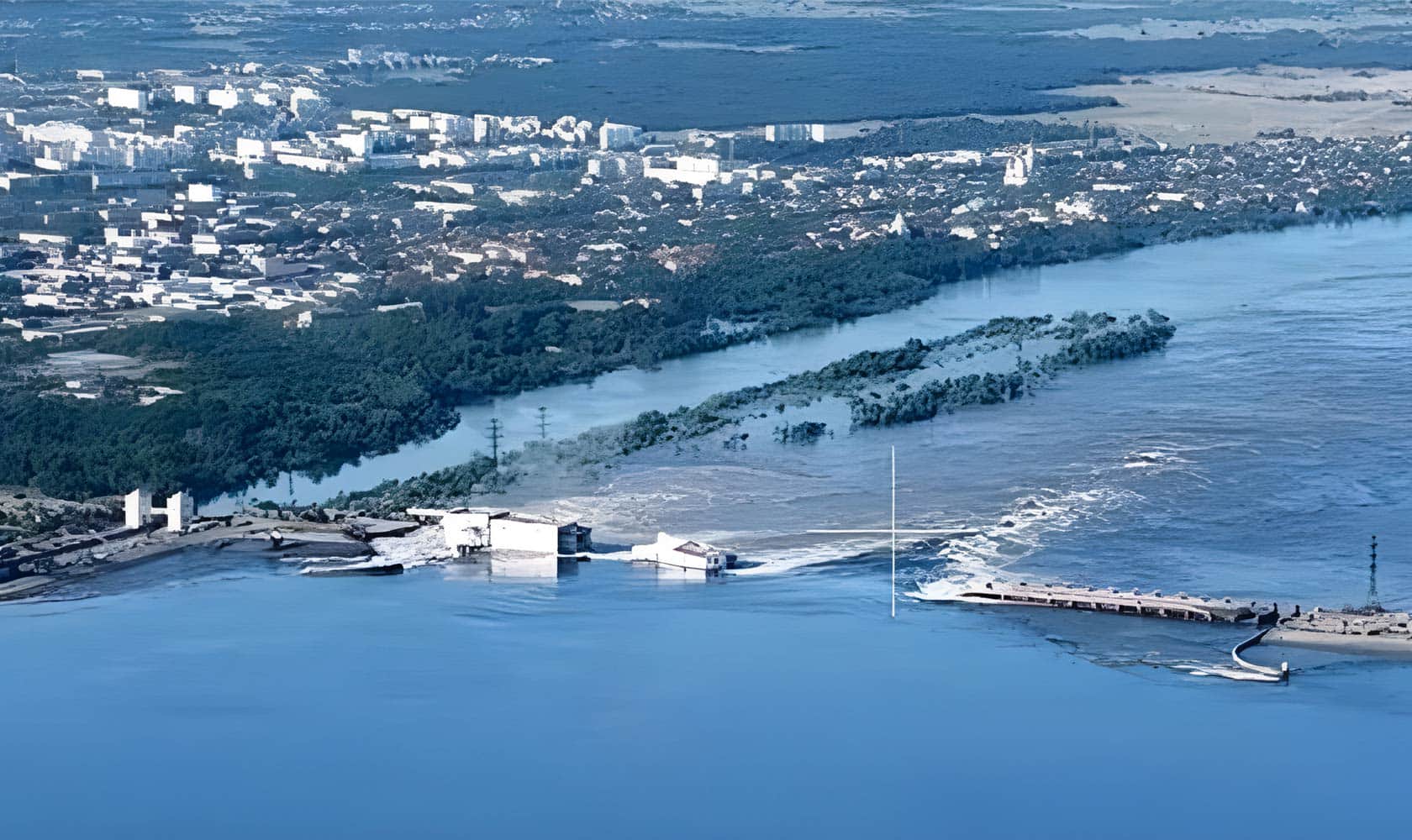
At 02:50 on 6 June, an anticipated disaster struck. It was warned about and feared, and sometimes even apocalyptic scenarios were used to describe its consequences.
Russian troops blew up the Kakhovka Hydroelectric Power Plant (HPP) dam, a station that supplies southern Ukraine with electricity and fresh water.
This station is also important for the functioning of the Zaporizhzhia Nuclear Power Plant (ZNPP), as the capacity of the latter’s cooling ponds depends on the water level in the Dnipro River.
In the first hours following the explosion, eight settlements and one micro district on the right bank of the Dnipro River in Kherson experienced either complete or partial flooding.
About 16,000 individuals living on the right bank of Kherson Oblast found themselves within the critical zone. The left bank, currently occupied by the Russians, faced an even graver peril due to its lower terrain.
What happened
Operational Command Pivden (South) was the first to officially report that the Russians had blown up the Kakhovka HPP. However, earlier this information began to appear in pro-Russian Telegram channels - where, unsurprisingly, the blame was placed on the Ukrainian side rather than the occupying forces.
There are no specific details regarding how the dam was destroyed.
There was only one explosion, and then the Kakhovka HPP "collapsed like a house of cards," a resident of Nova Kakhovka, who had moved to the territory controlled by Ukraine, shared with UP.
The dam and turbine hall of the HPP, which was blown up from the inside, were destroyed, as reported by Ukrhydroenergo. According to their estimates, the damage is so significant that it will be impossible to repair the station.
Відео з підірваної росіянами Каховської ГЕС. Відео з Telegram Spravdi pic.twitter.com/4HRlRLO3vR
— Українська правда ✌ (@ukrpravda_news) June 6, 2023
The Ministry of Internal Affairs began evacuating residents from flooded villages. The Oblast Military Administration organised the supply of water in the north of Kherson Oblast. Residents of Kherson were advised to move to safer areas if the water rises to a level of up to 5 metres.
The city established three assistance centres to support its residents.
"The dam is badly damaged, but not completely. In the later videos, you can see that there is no big drop in water. This is due to the terrain because it is not a mountain dam, but on a flat area, already close to the mouth of the river itself," reported UP Serhiy Gapon, the head of the World Laboratory of the Data Centre for Geoinformatics and Sustainable Development.
However, he noted that it is difficult to assess the extent of the destruction solely from the video footage. The speed at which the surrounding areas are flooded depends on which portion of the dam remains submerged.
According to his estimates, spills on the left bank could reach deep into the territory up to a couple of dozen kilometres. As a result, all settlements located 2-2.5 km from the banks of the Dnipro would be flooded.
But the largest number of people may be affected in Kherson, which is the most densely populated city.
"The water will continue to spread for several days in certain areas because there are local depressions. And they will take a long time to fill up. It is in these local depressions that water may remain for several months. However, after a few days, the water level will decrease in other areas," thinks Gapon.
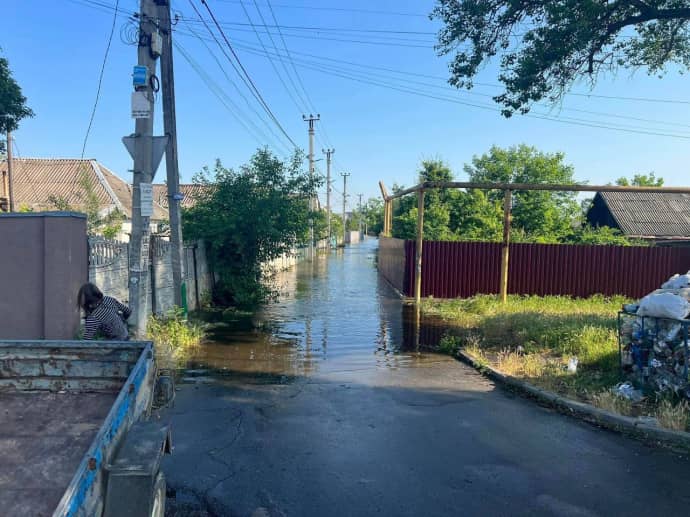
Reaction of the Ukrainian authorities: NSDC, appeal to the UN Security Council, Cabinet of Ministers
President Volodymyr Zelenskyy called an emergency meeting of the National Security Council in the early hours of 6 June.
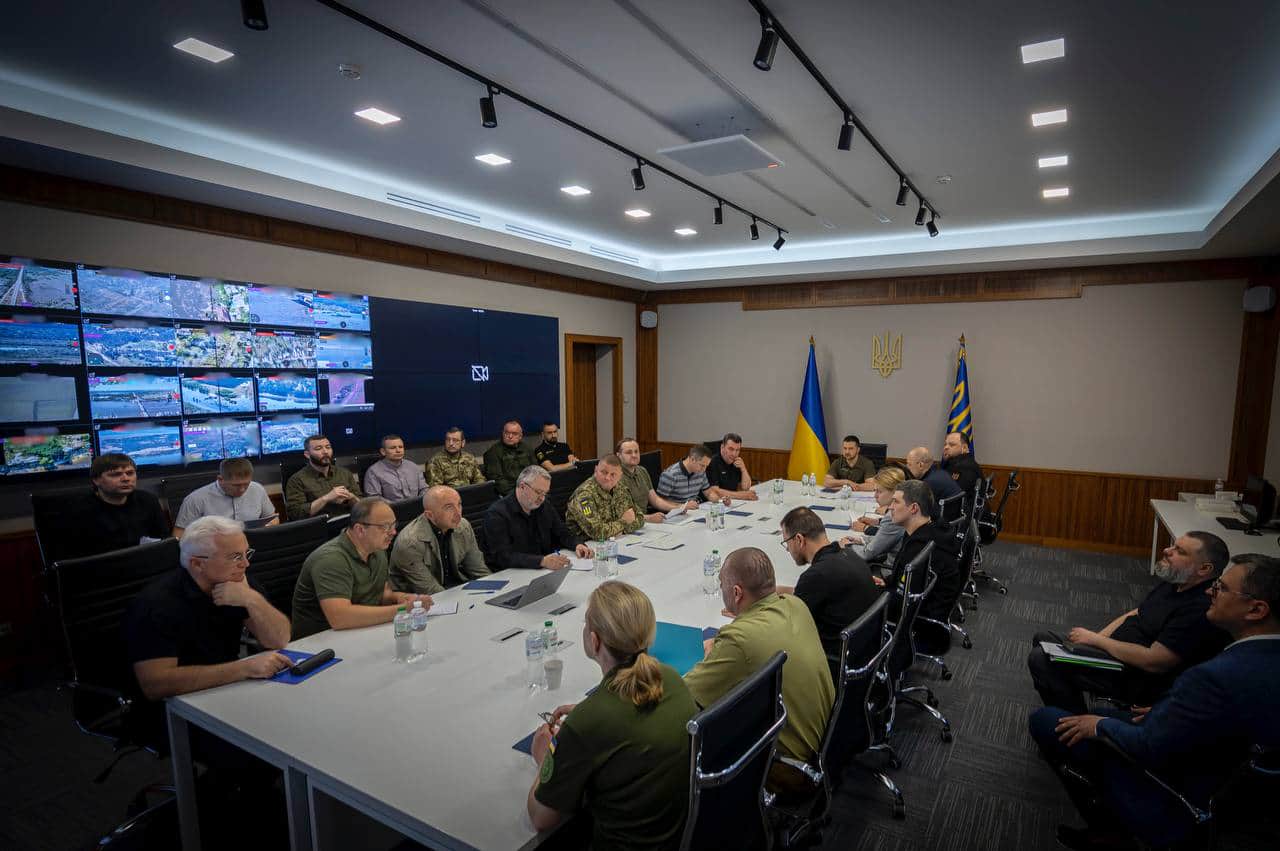
In addition to the full attendance of the Security Council, including Zelenskyy himself; Oleksii Danilov, Secretary of the National Security Council; Andrii Yermak, Head of the Office of the President; Valery Zaluzhny, Chief of the Armed Forces of Ukraine; other law enforcement officers and Foreign Minister Dmytro Kuleba, the following were invited to the meeting:
Acting Minister of Ecology Oleksandr Krasnolutskyi;
Petro Kotin, Chairman of Energoatom and Ihor Syrota, CEO of Ukrhydroenergo [Ukrainian hydroelectric power regulator];
As one of the participants of the meeting told UP, it was very dynamic.
"Everyone reported very quickly and clearly, without unnecessary emotions: who knows what, what the prospects are, what the work plans are. After a short discussion, everyone went back to work," says Ukrainska Pravda’s (UP’s) source from among the NSDC members.
One piece of information from the Ukrainian National Security Council said that the Russians blew up old explosives, which Zelenskyy had warned about in his address to the European Council last autumn.
"At the meeting, the military personnel reported the exact time of the explosion - around 03:00. They assured us that it was not their work, and there was no shelling from our side. This explosion was carried out by the Russians. Everyone was given an assignment as to who is doing what: who is informing the International Criminal Court, who communicates with the UN Security Council, and so on," the informer adds.
According to UP, the Minister of Foreign Affairs, Dmytro Kuleba, was assigned with initiating an urgent convening of the UN Security Council.
The NSDC reported that Kherson would be flooded by heavy water in about a day, but the level would drop to normal in 4-6 days.
Following the results of the meeting, Zelenskyy reported that there were about 80 settlements in the flooded zone.
They also discussed safety at the Zaporizhzhia Nuclear Power Plant. The fact is that its cooling system is synchronised with the water in the Kakhovka reservoir. However, Kotin and other energy experts assured that for now there is no critical threat to the ZNPP, as the cooling system operates autonomously.
After the NSDC meeting, emergency meetings of the Technogenic and ecological safety and emergencies commission were held, chaired by Prime Minister Denys Shmyhal.
Evacuation and the placement of people in safe areas were identified as the main task. The evacuation was planned from Kherson and Mykolaiv by train to Khmelnytskyi. The first trains left Kherson on 6 June at 13:00.
A separate issue during the floods is the provision of drinking water to all affected regions: Dnipropetrovsk, Zaporizhzhia, Mykolaiv, and Kherson.
As Shmyhal reported, at the government meeting on Tuesday, 120 million hryvnias were allocated to the State Water Resources Agency for the Mykolaiv water supply. Water is planned to be supplied through the Ingulets River.
How the blowing up of the dam will affect Ukraine's offensive in the South
The front line in Kherson Oblast has not moved since November 2022. However, despite this, the south is considered one of the key potential areas for a major offensive by the Ukrainian army.
To liberate the South, the Armed Forces of Ukraine will have to move to the other side of the Dnipro River. However, where exactly this will be - from the Kherson (by water) or Zaporizhzhia (by land) side - is currently unknown.
If Ukraine advances from Kherson, then the flooding of the river will firstly physically increase the distance between Ukrainian and Russian troops, and secondly it will make it difficult to use heavy equipment during the operation.
However, as people's deputy and military member Roman Kostenko tells UP, he does not observe signs of preparations for the offensive from the Dnipro - in other words, an offensive from Kherson. Therefore, according to Kostenko, the blowing up of the dam will not affect the offensive in any way:
"Our active actions to force the Dnipro River in the south were unlikely, they would have entailed heavy losses. After forcing a crossing over the river, we still needed to hold the bridgehead... But the enemy still played it safe and blew up the dam. The dam was the only place that connected the right and left banks (Kherson Oblast - UP)".
UP has data that somewhat differs from Kostenko's forecasts but is not disclosing them for security reasons.
The immediate military consequences of the detonation include the previously mentioned increase in distance between the Ukrainian and Russian armies. According to Kostenko's rough estimates, this is about 10 kilometers:
"Now some types of weapons will no longer reach Kherson and at the same time, some will not reach the Russians. But for now, we are only predicting this, everything will have to be "flown and reconnoitred".
According to Kostenko, the Russians did not leave "significant troops" on the neighbouring, left bank of Kherson Oblast - there is only one airborne division there, and all the others are "mobs", the Russian Guard, etc.
"Significant" Russian troops are currently deployed on the Zaporizhzhia front.
What is happening in the occupied part of Kherson Oblast
During the morning of 6 June, the Russians changed their version of events regarding the explosion several times - a classic behaviour of Moscow propaganda.
When the first reports about the explosion appeared online, RIA Novosti at 06:00, citing the occupier’s appointed "mayor" of Nova Kakhovka, Volodymyr Leontiev, called it "nonsense". The Russians wrote that "everywhere is quiet and peaceful" in the city.
At the same time, some pro-Russian members of the public dispelled the idea that the dam collapsed "because it could not withstand the damage that was inflicted on it earlier."
Затоплений Палац культури у Новій Каховці. Відео з Telegram-каналу Astra pic.twitter.com/QQhOOXMzOQ
— Українська правда ✌ (@ukrpravda_news) June 6, 2023
Within an hour, the same Leontiev spoke of "a series of numerous strikes" that "destroyed the latches" and blamed the Ukrainian Armed Forces.
At the same time, the occupying authorities lied that "the dam itself was not destroyed" and told uninformed residents that "the situation is under control."
The residents of Nova Kakhovka did not receive any instructions from the occupiers after the dam was blown up, as the city's mayor, Oleksandr Kovalenko, told UP.
One of the residents of Nova Kakhovka, who left the city a few months ago, told UP that currently "there is almost no FSB, there are only ordinary infantry who do not understand what to do at all" in the flooded areas of the city.
Later, the occupying authorities of Nova Kakhovka announced that some people were being evacuated.
Residents of Nova Kakhovka, Hola Prystan and Oleshky began to receive messages from the Russian Ministry of Emergencies. They were urged to collect necessities, documents, food, and water for three days.
Consequences for Zaporizhzhya NPP
An uncontrolled decrease in the level of the reservoir is extremely dangerous for the operation of the Zaporizhzhya NPP, which is currently under occupation.
Water from the Kakhovsky Reservoir is necessary for the station to receive a supply for turbine capacitors and safety systems.
The Main Intelligence Directorate of Ukraine stated that the blowing up of the reservoir dam "increases the threat of a nuclear disaster."
Earlier, the Main Intelligence Directorate of the Ukrainian Ministry of Defence reported that the Russians had begun to mine the Kakhovska HPP immediately after its capture. In April of last year, the occupiers additionally mined the locks and pillars and installed tented trucks with explosives on the dam itself.
Read also: What is happening to the Kakhovsky Sea during the War and what are the consequences
Nuclear energy and nuclear safety expert Olga Kosharna says that the situation at the Zaporizhzhia NPP is under control.
"The water level in the cooling pond is now 16.6 metres (Energoatom noted that this is sufficient for the plant's needs - UP). There are also sprinkler pools and a cooling pond at the Zaporizhzhia TPP. In conditions when the power units are in cold shutdown, and the fifth power unit is in hot shutdown, there is enough water to cool the reactors and spent nuclear fuel storage pools, which are at each reactor," she explains to UP.
The expert also reminds us of the existence of mobile pumping stations with hoses two kilometres long, from which water can be collected from the Dnipro.
"But the problem is that the orcs mined the shore at Energodar. And I hope that they had enough brains to make maps of the minefields," says Kosharna.
Consequences for Crimea
The blowing up of the Kakhovka HPP will also affect the water supply to occupied Crimea. The North Crimean Canal, which began to fill up after the Russian invasion of Kherson Oblast, will again be left without water.
"The canal was connected to a large hydraulic structure, including the Kakhovska HPP. And if the level drops rapidly - and it is falling - then the water simply will not be able to enter the canal. It will only be possible to pump it with super-powerful pumps, and this will not happen," explains Serhiy Gapon.
Read also: What happens to occupied Crimea without water from the Dnipro. 13 facts
According to his assessment, water may stop flowing to the canal in the coming days.
Who was guarding the Kakhovska HPP?
This brigade is known for having participated in the first Chechen war and has the motto "205th brigade, we will return even from hell." Currently, personnel mostly mobilised from different parts of Russia are fighting here.
"Mostly, there are guys who worked in villages, factories, far from military affairs," is how a Russian occupier from the 205th brigade with the alias "Viper" commented in the media about the experience of his colleagues guarding the Kakhovka HPP.
These are fighters from Stavropol and central Russia. In addition to them, there are also graduates from the Novosibirsk and Ryazan Higher Military Schools.
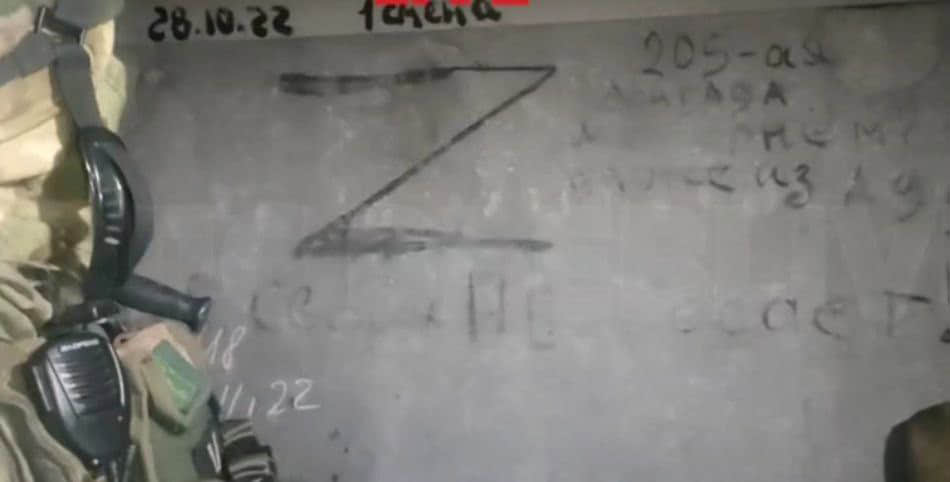
The contract soldiers are mostly those who fought in the North Caucasus.
The alias of the battalion commander guarding the HPP is "Krasnoyarsk". This has not been made public, and Russian propagandists only mention its existence in their stories.
His deputy, Polygon, awarded soldiers with the Order For Courage in the centre of occupied Nova Kakhovka in December 2022.

The commander of the assault company was "Saratov'', who led the assault on Snigurivka in Kherson Oblast. The commander of the reconnaissance unit, "Tura'', told how he and his group penetrated the territory controlled by Ukraine to carry out combat missions." The artillery commander is called Luty. He is responsible for working with helicopters and identifying Ukrainian positions.
"Georgian", "Vasyok", "Veter", "Tashkent", "Bugai", and "Nemets" are fighters of the 205th brigade, whom we also noticed in the occupiers’ video.
Constant support for the brigade was expressed on social networks by representatives of the Wagner PMC, and some of the representatives of the 205th brigade wore the "Main Intelligence Directorate" chevron with the image of a bat and the inscription of the "Vityaz" special unit.
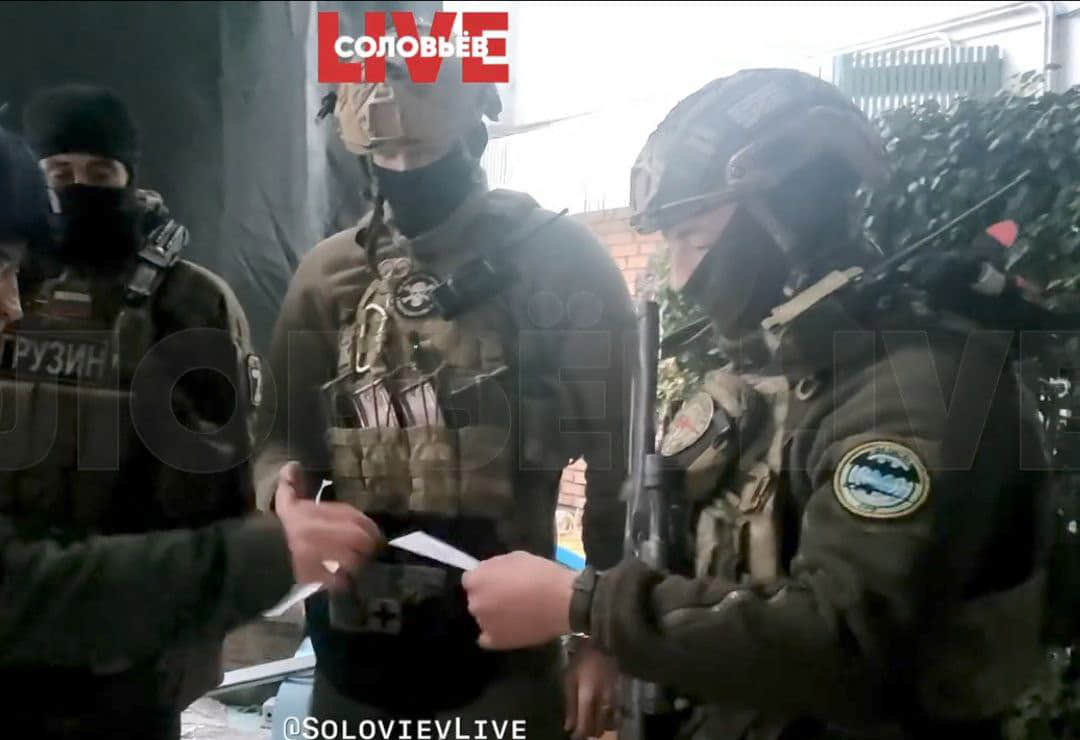
Representatives of the 205th brigade of the Armed Forces of the Russian Federation on the territory of Kakhovskaya HPP
The commander of the 205th brigade is 40-year-old Lieutenant Colonel Eduard Shandura.
Earlier, Ukrainian intelligence reported that he was removed from combat duties in order to participate in the parade in destroyed Mariupol in May 2022. Last autumn, some Ukrainian Telegram channels reported that Shandura had been killed in Kherson Oblast.

According to our analysis, representatives of the 359th Motorized Rifle Regiment of the Russian Armed Forces are also based at positions near the HPP. Previously, they denied information that they did not have adequate military support.
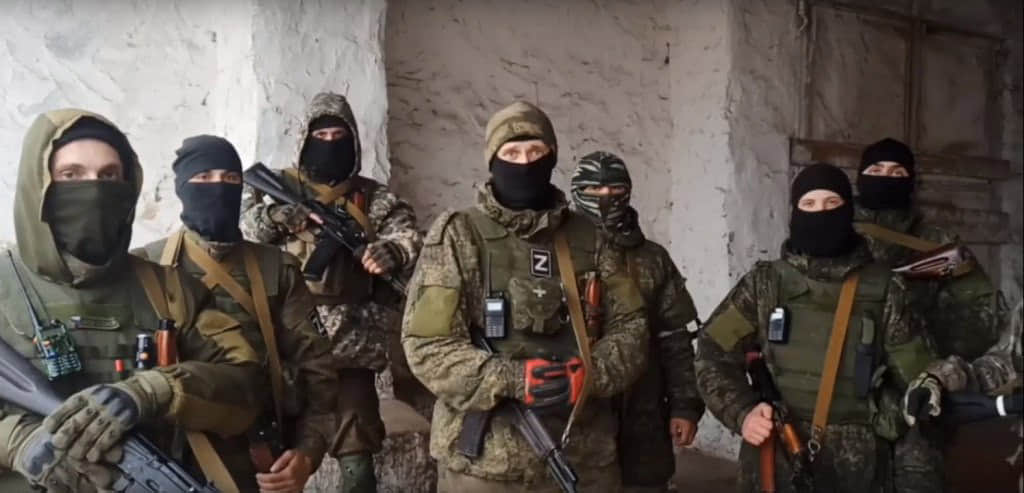
In one of the latest stories by the occupiers about the situation at the Kakhovskaya HPP, a Russian military officer says that the main task of the guards is to prevent Ukrainian saboteurs from breaking through from the right bank of the Dnipro, and talks about a possible explosion.
"A lot of effort would be required to destroy the dam. I am not even considering such an option. It would be a real flood for the nearest settlements," said the soldier.
Is blowing up a dam a crime? As it occurred in the wars of the 20th century
The destruction of hydroelectric power plants is a crime, a violation of the worldwide accepted rules of war. The Geneva Convention, written after World War II, expressly forbids attacking dams and dikes.
There is no exception if such facilities are used by the military. And even if such an attack is aimed at stopping criminals. The reason is clear - severe and uncontrollable consequences for civilians. And the general principles of the Convention prescribe the protection of civilians and the avoidance of attacks, the consequences of which cannot be limited.
An attack on a dam is permissible only if its use is "different from its normal functioning" and only an attack would stop the important military role of the dam. This is not the case for the Kakhovka HPP.
Dams have been blown up more than once in the history of world wars. During the Spanish Civil War in 1937, Francisco Franco's troops tried, but failed, to destroy a56-metre dam with 15 tonnes of explosives.
In 1943, the British bombed three German dams, two of them in one day. This significantly damaged power plants and destroyed bridges. The breach of one of the dams caused a 10-metre wave of water and the death of about 1,200 people
In the Korean War of the 1950s, both sides attacked the Gwacheon Hydroelectric Plant.
An example that has already occurred in the current international law framework is the war in the former Yugoslavia.
In 1993, the Serbs blew up the Peruća dam in Croatia. This was done to stop a successful counteroffensive by Croatian troops. The Serbs then, like the Russians now, blamed the artillery of their opponents.
Forecasts warned about the threat of flooding for approximately 50,000 people. But, although about 30 tonnes of explosives were laid under the Peruća dam, it was fortunately not destroyed.
The situation was saved by the fact that Croatian troops took control of the HPP on the day of the disaster. That is why the authorities were able to immediately tackle the consequences.
Croatia formally charged General Borislav Dzukic with the explosion. As recently as 2015, he was detained and put on trial. Dzukic was sentenced to 10 years in prison, but his sentence has now been overturned due to procedural violations, so the trial is still ongoing. The court recognized that the damage from the explosion amounted to about 17.5 million euros.
How the Dniprovska HPP was blown up in 1941
Scorched (flooded) earth tactics are nothing new for Russian military strategy.
The circumstances of the explosion of the Kakhovskaya HPP on 6 June 2023 are in many ways reminiscent of the explosion of the Dnipro HPP on 18 August 1941.
To slow down the advance of German units to the east, NKVD officers, having laid 20 tonnes of explosives in advance, destroyed a part of the dam 165 metres long. The operation was prepared in secrecy, so even the Soviet army command on the ground was not ready for the consequences of the explosion.
The HPP dam also served as a bridge for Red Army units and refugees to cross the Dnipro. As a result of the explosion of the Dnipro HPP dam, according to various estimates by historians, 20,000 to 100,000 Red Army soldiers and civilians died.
The flood caused by the explosion at the dam cut off parts of the Soviet troops located downstream of the Dnipro, and they were later forced to surrender to the Germans.
The first reaction of Soviet propaganda was predictable: the Germans were blamed for blowing up the Dnipro HPP.
The encyclopaedia "History of Cities and Villages of the Ukrainian SSR" (1981) wrote about this event as follows: "The railway bridge over the new channel of the Dnipro and part of the dam was blown up. A giant waterfall washed away several enemy crossings and drowned many fascist units hiding in the floodplains." Not a word was mentioned about the fact that the Red Army soldiers who were at the dam itself and the approaches to it were killed.
Interestingly enough, the destruction of the dam did not hinder the plans of the Wehrmacht. The Germans established crossings upstream of the Dnipro.
Consequences for wildlife
The consequences of blowing up the Kakhovka Reservoir dam are often described as an "ecological disaster." For example, due to the destruction of the Kakhovka HPP, at least 150 tonnes of engine oil have already entered the Dnipro, and even more may spill later. But despite this, the statement about "ecological catastrophe" needs an explanation, because it has another side.
The so-called Lower Dnipro sands stretch along the left bank of the Dnipro River below Kakhovka for about two hundred kilometres. Among other things, the famous Oleshky sands and Kinburn spit are located here. In this part of Ukraine, the Black Sea Biosphere Reserve, the Nizhny Dniprovskiy National Park, the Svyatoslav White Coast, and several other nature conservation areas have been created.
Among other things, the presence of these areas in the nature reserve reflects the uniqueness of the ecosystems formed on the sands of the Lower Dnipro. Many species of plants and animals that inhabit them are used to exactly such soils and such a climate, so they feel good here and will not be able to live normally in other conditions.
Mykhailo Rusin, who has a PhD in Biological Sciences from the Kyiv Zoological Park, who has been studying the nature of the Nizhny Dnipro sands for a long time, says that some local species or subspecies of animals are endemic. That is, they are not found anywhere else on the planet.
These are, for example, the sandy blind mole-rat and the Sciropoda Telum. Both are included in the Red Book of Ukraine, as well as in the Red List of the International Union for Conservation of Nature (IUCN).
The steppe mouse is not endemic. It lives in the Crimea, the East, and some other regions. There are also populations in neighbouring countries. But, according to Mykhailo Rusin, approximately 70% of these animals live in the Nizhny Dnipro sands.
The effects of flash flooding on these and other small terrestrial animals are likely to be severe, if not fatal. After all, unlike birds or large mammals, they will not be able to physically escape from the water that will flood the places where they live.
However, Mykhailo Rusin cannot say for sure what awaits this or that population of animals today. After all, it will depend, in particular, on the real scale of the flooding, which will become clear shortly.
The most unexpected consequence is that, in the long run, wildlife may benefit from the dam's destruction. At the same time, people may also benefit.
For example, the dam blocked the way for some species of fish that migrated to the upper reaches of the Dnipro to spawn. This, in particular, hit the sturgeon population.
In addition, the artificial reservoir buried vast plains at its bottom. Previously, they provided not only grazing for a large number of livestock but also a place for the spawning of countless fish.
The Dnipro, which every spring overflowed and desalinated seawater up to Odesa, has turned into a controlled water flow. This has had negative consequences for floodplain ecosystems, which had adapted to a completely different regime over thousands of years.
The destruction of the dam, from the point of view of wildlife, means that it is returning closer to its original state. To a certain extent, it is taking back what once belonged to it. The future fate of nature will depend on whether the destroyed dam is rebuilt.
"Theoretically, if the reservoir is not restored, the canals are not restored, then we could talk about the restoration of traditional, sustainable nature management. For example, the restoration of sheep farming. This could be a huge ecological plus. But for this, the war must end, and that then there was a certain understanding of how to develop and restore these territories," says Mykhailo Rusin.
Ukrainska pravda
The text was worked on by Rustem Khalilov, Olga Kirylenko, Roman Romanyuk, Viktoriya Roschyna, Sonia Lukashova, Mykhailo Krygel, Dmytro Simonov
Translation: Kamila Fomin
Editing: Susan McDonald